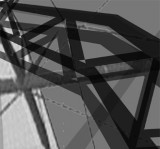Supervisor:
2006
Iron came after the main structural materials (stone and timber), and followed structures that they had established. Its form developed during time giving the freedom possibility in drawing.
The use of iron in the architecture began supporting the structures that were made from stone or timber. During the industrial revolution the first applications were made in structures with new functions. The growth of railway networks facilitated its distribution and established new technologies. Its appearance in public buildings became later in two libraries of France. It was applied in exhibition centers and bridges creating buildings with important meaning in metal structures. The extension of airplanes led its use for the construction of sheds. At the same time the technological growth of shipbuilding and aeronautics borrowed technologies in architecture.
After that, the metal structures came through a period of experimentation that is characterized from a particular style with constructions in cultural uses. There were developed new structures such as the geodetic domes, space frames and structures with elements of suspension. Buildings were constructed that imported the significance of standardization, prefabrication and reconstruction.
In the industrial buildings created long open spaces providing flexibility and possibility of future extension. It used to cover the infrastructures of transport, stadiums and athletic field.
The last decade there were made constructions with free form and erratic geometry. This is called fluid architecture that is developed with the help of computer.
Steel passes through three stages in order to reach in the final form. From the blast furnace, that through the treatment of iron is produced the steel and its primary products. These products are led to steel service center and accept more treatments for the production of products as open or closed cross-sections. Finally constructor receives the products and takes over the assembly and treatments for the production of final forms as hollow sections or custom curved elements, frames and space frames.
The world production of steel is in continuous rise. The capability to be completely recycled in combination with the reducing consumption of energy and the small emission of pollutants during production renders the steel industry friendly to the environment beside other materials.
Metal constructions passed through tests and experimentation and they covered a period of maturity. Steel after his exploitation in strength and technologies comes to serve the new architectural forms. The architects turn their interest in the research of new forms in order to attribute their personal style, with steel to be offered for form solutions.
